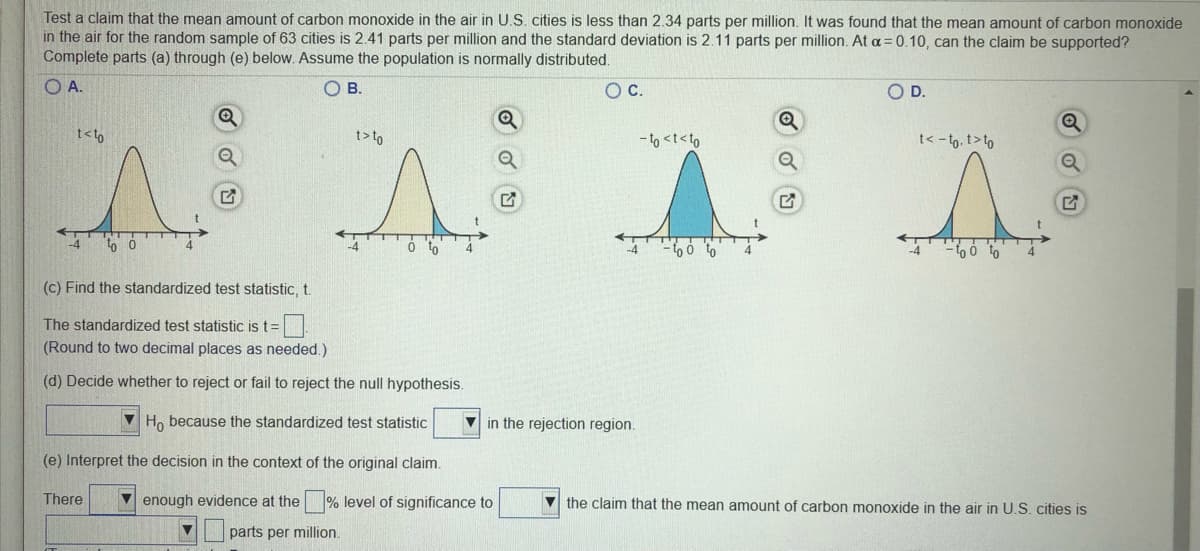Test a claim that the mean amount of carbon monoxide in the air in U.S. cities is less than 2.34 parts per million. It was found that the mean amount of carbon monox in the air for the random sample of 63 cities is 2.41 parts per million and the standard deviation is 2.11 parts per million. At a = 0.10, can the claim be supported? Complete parts (a) through (e) below. Assume the population is normally distributed. O A. OB. OC. OD. tto - to to (c) Find the standardized test statistic, t. The standardized test statistic is t=| (Round to two decimal places as needed.) (d) Decide whether to reject or fail to reject the null hypothesis. V H, because the standardized test statistic V in the rejection region. (e) Interpret the decision in the context of the original claim. There enough evidence at the % level of significance to V the claim that the mean amount of carbon monoxide in the air in U.S. cities is parts per million
Test a claim that the mean amount of carbon monoxide in the air in U.S. cities is less than 2.34 parts per million. It was found that the mean amount of carbon monox in the air for the random sample of 63 cities is 2.41 parts per million and the standard deviation is 2.11 parts per million. At a = 0.10, can the claim be supported? Complete parts (a) through (e) below. Assume the population is normally distributed. O A. OB. OC. OD. tto - to to (c) Find the standardized test statistic, t. The standardized test statistic is t=| (Round to two decimal places as needed.) (d) Decide whether to reject or fail to reject the null hypothesis. V H, because the standardized test statistic V in the rejection region. (e) Interpret the decision in the context of the original claim. There enough evidence at the % level of significance to V the claim that the mean amount of carbon monoxide in the air in U.S. cities is parts per million
MATLAB: An Introduction with Applications
6th Edition
ISBN:9781119256830
Author:Amos Gilat
Publisher:Amos Gilat
Chapter1: Starting With Matlab
Section: Chapter Questions
Problem 1P
Related questions
Topic Video
Question
Please correctly state H0 and Ha.
The options for the claim is the ___hypothesis is either “null” or “alternative”
Part D options are)
First part “reject” or “fail to reject” and the last part is “is” or “is not”
Part E)
First part “is” or “is not”, second part “support” or “reject”, and the last part’s options are
“Less than equal”, “less than”, “equal”, “not equal”, “greater than or equal”, and “greater than”

Transcribed Image Text:(c) Find the standardized test statistic, t.
The standardized test statistic is t=
(Round to two decimal places as needed.)
(d) Decide whether to reject or fail to reject the null hypothesis.
V Ho because the standardized test statistic
V in the rejection region.
(e) Interpret the decision in the context of the original claim.
There
V enough evidence at the % level of significance to
the claim that the mean amount of carbon monoxide in the air in U.S. cities is
parts per million.
(Type integers or decimals. Do not round.)

Transcribed Image Text:Test a claim that the mean amount of carbon monoxide in the air in U.S. cities is less than 2.34 parts per million. It was found that the mean amount of carbon monoxide
in the air for the random sample of 63 cities is 2.41 parts per million and the standard deviation is 2.11 parts per million. At a = 0.10, can the claim be supported?
Complete parts (a) through (e) below. Assume the population is normally distributed.
O A.
OB.
Oc.
OD.
t<to
t>t9
- to <t<to
t< -to, t>to
-4
(c) Find the standardized test statistic, t.
The standardized test statistic is t=
(Round to two decimal places as needed.)
(d) Decide whether to reject or fail to reject the null hypothesis.
Ho because the standardized test statistic
V in the rejection region.
(e) Interpret the decision
the context of
original
There
V enough evidence at the % level of significance to
V the claim that the mean amount of carbon monoxide in the air in U.S. cities is
parts per million.
Expert Solution
This question has been solved!
Explore an expertly crafted, step-by-step solution for a thorough understanding of key concepts.
This is a popular solution!
Trending now
This is a popular solution!
Step by step
Solved in 3 steps

Knowledge Booster
Learn more about
Need a deep-dive on the concept behind this application? Look no further. Learn more about this topic, statistics and related others by exploring similar questions and additional content below.Recommended textbooks for you

MATLAB: An Introduction with Applications
Statistics
ISBN:
9781119256830
Author:
Amos Gilat
Publisher:
John Wiley & Sons Inc

Probability and Statistics for Engineering and th…
Statistics
ISBN:
9781305251809
Author:
Jay L. Devore
Publisher:
Cengage Learning

Statistics for The Behavioral Sciences (MindTap C…
Statistics
ISBN:
9781305504912
Author:
Frederick J Gravetter, Larry B. Wallnau
Publisher:
Cengage Learning

MATLAB: An Introduction with Applications
Statistics
ISBN:
9781119256830
Author:
Amos Gilat
Publisher:
John Wiley & Sons Inc

Probability and Statistics for Engineering and th…
Statistics
ISBN:
9781305251809
Author:
Jay L. Devore
Publisher:
Cengage Learning

Statistics for The Behavioral Sciences (MindTap C…
Statistics
ISBN:
9781305504912
Author:
Frederick J Gravetter, Larry B. Wallnau
Publisher:
Cengage Learning

Elementary Statistics: Picturing the World (7th E…
Statistics
ISBN:
9780134683416
Author:
Ron Larson, Betsy Farber
Publisher:
PEARSON

The Basic Practice of Statistics
Statistics
ISBN:
9781319042578
Author:
David S. Moore, William I. Notz, Michael A. Fligner
Publisher:
W. H. Freeman

Introduction to the Practice of Statistics
Statistics
ISBN:
9781319013387
Author:
David S. Moore, George P. McCabe, Bruce A. Craig
Publisher:
W. H. Freeman